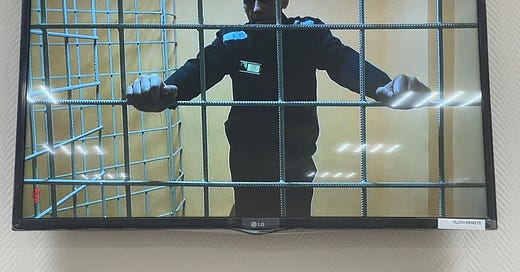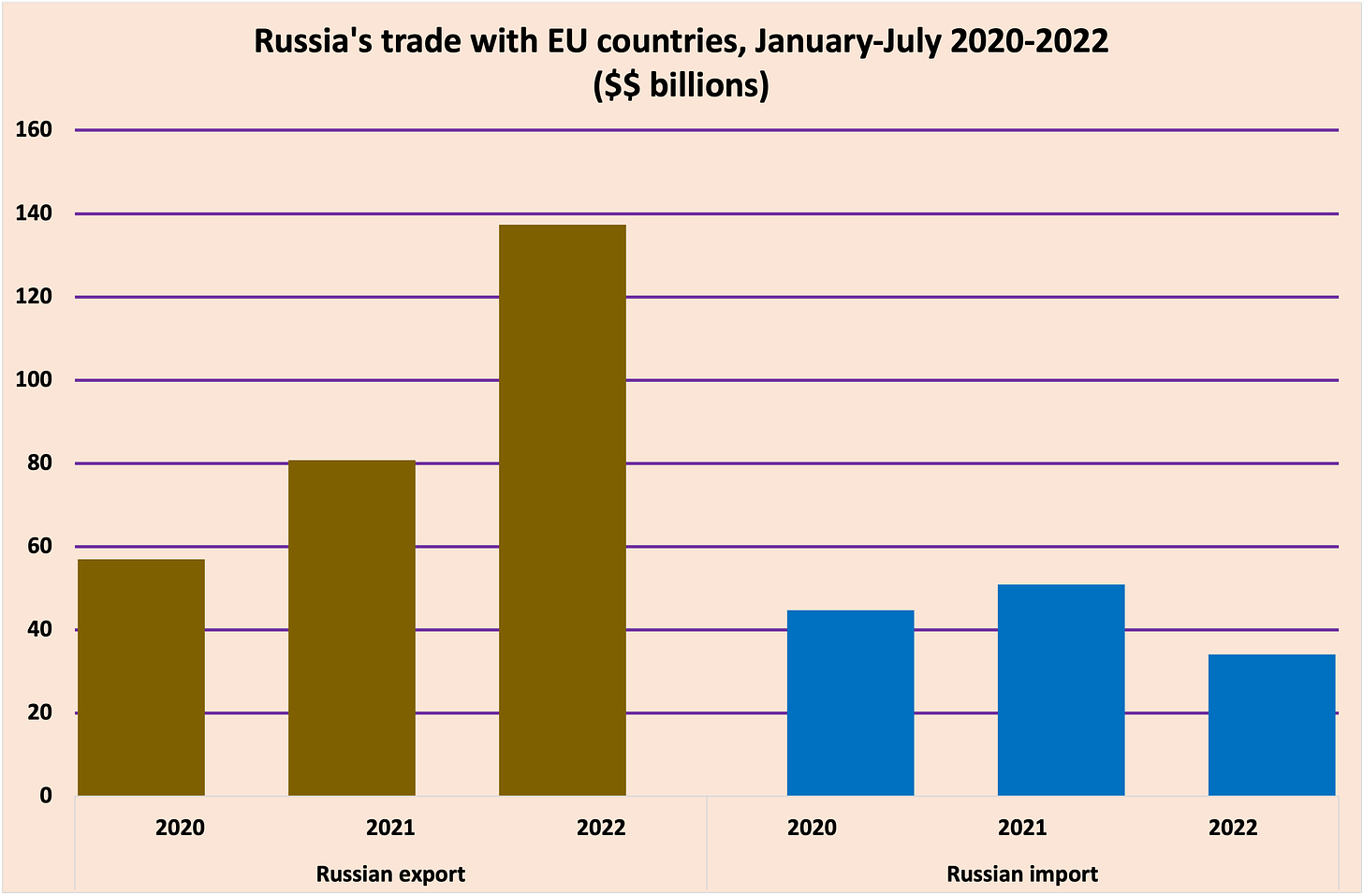October 4, 2022
Fighting from the outside
It’s going on
…though with minor (?) problems
…and scaring Russians
…though they are ready to go for a war
The drop, not the collapse
Just a fact
Making my assessment
Fighting from the outside
Opposition leader Alexei Navalny’s comrades-in-arms in exile decided to revive the network of regional organizations, whose activities were terminated after the Moscow prosecutor’s office demanded that “the public movement ‘Navalny headquarters’ be recognized as an extremist organization.” Navalny himself has already been in a Russian prison for 2.5 years—Russian courts have sentenced him to a total of nine years in prison for his political activism.
Navalny’s lieutenants, Ivan Zhdanov and Leonid Volkov, who initiated the network’s revival, were motivated because people who until recently remained outside politics “are beginning to realize the truth or at least ask questions.”
The decision was made due to the weakening of Putin’s regime after seven months of war and mobilization.
This situation is unique: It has never happened before in recent years. The sleeping majority woke up. Putin himself woke it up. And that is why we must act right now. Maybe tomorrow it will be too late.
Navalny’s supporters have announced that the new network will be unrelated to the old one and that they will recruit employees from scratch. Realizing that “the risks are much higher than they were four years ago,” they say that the new network will be like a guerrilla underground, with a significant emphasis on security.
No one will know you’re a member of our headquarters unless you want to be. There will be no single list of coordinators and participants.
The precautions announced do not seem excessive: After Navalny’s organization was declared extremist, the Russian authorities obtained a database of its supporters, which included tens of thousands of Russians. Many of them faced criminal prosecution afterward.
Navalny’s supporters were the first political force in Russia to declare the beginning of an active struggle using guerrilla methods. The fate of this initiative is difficult to predict, and it is even more challenging to assess how successful it will be. But there is no doubt that the external circumstances are favorable: Russian public opinion has moved in the wake of the announcement of the mobilization.
It’s going on
Russian Defense Minister Sergei Shoigu announced that more than 200,000 mobilized Russians had arrived in the Russian army in two weeks, out of the 300,000 that the military department had decided to send to war.
When the mobilization began, Shoigu stated that the mobilized would be sent to oversee Ukrainian territories that had come under Russian military control. Yet, today he clearly said that their task would be to participate in combat operations, in which they would soon be involved.
Soldiers should be sent to combat areas after training and combat readiness. To ensure that recruits adapt to combat conditions as quickly as possible, [I order] to conduct additional training with them under the guidance of officers with combat experience. The use of these units should be planned only jointly with those units already participating in an extraordinary military operation.
…though with minor (?) problems
While Minister Shoigu claims that mobilization is proceeding in an orderly manner, with minimal problems, the Russian Antimonopoly Service (FAS) has sent inquiries to three major marketplaces about the prices of army equipment. The FAS demanded information on “weighted average, maximum, and minimum selling prices” and the dynamics of sales volumes of the said products in August and September.
The FAS explained that the inspection and study of the situation on the market were carried out in connection with the appeals of deputies of the State Duma and numerous complaints of citizens about the unjustified growth of uniforms, gear, and military equipment prices.
According to the trading platforms, the demand for military equipment in Russia increased more than fivefold after the mobilization began. Online sales of tactical goggles increased the most, by 694%, and of body armor, by 472%. Demand for tactical gloves and backpacks increased by more than 300% (441% and 319%, respectively) and universal folding tool kits by 457%. The trigger for the rush in demand was the numerous instances of Russians being told at mobilization sites that the army could not provide them with the necessary ammunition and that they had to buy everything themselves.
…and scaring Russians
Sociological services began to publish the results of surveys conducted after the announcement of the mobilization, which show a sharp increase in anxious moods and fears among Russians. Thus, according to a poll by the pro-Kremlin Center for Public Opinion Research (FOM), before mobilization began (poll September 16-18), 57% of Russians characterized their mood as “calm” and 25% as “anxious.” A week later (September 23-25), the ratio of opinions was reversed: Only 26% of respondents were calm, and 69% said they were worried.
According to a Levada-Center poll, almost half of all Russians (47%) said that the announcement of the beginning of mobilization caused “anxiety, fear, and dread,” an assessment that did not vary significantly by age. On the other hand, the subsequent two emotions—“shock” and “pride for Russia,” indicated by 23% of respondents each—clearly showed that support for the war and support for mobilization are concentrated among older Russians who are not threatened by mobilization. While young Russians (18-24 years old) mentioned “shock” three times more frequently than “pride in Russia” (31% vs. 9%), the ratio among older respondents (over 55 years old) was the opposite (15% vs. 27%).
According to the results of the poll conducted by the Russian Field service (September 29-October 1), 64% of Russians support the decision on mobilization, and 31% do not support it. Not surprisingly, this figure grows with age: If among young people (18-26 years old), 56% of respondents are against partial mobilization, then over 70% of those over 44 support it.
Two-thirds of Russians, according to opinion polls conducted by the Levada-Center, fear that general mobilization will be declared in Russia soon (36%—definitely, 30%—soon), which is 2.5 times higher than at the end of February (11% and 17%, respectively).
…though they are ready to go for a war
However, the fears and concerns of Russians are not yet the reason for them to avoid the draft at any cost: According to the poll Russian Field, 62% of the interviewed men confidently say that they will go to the military registration and enlistment office if they receive a summons; 15% name this variant of actions as the most probable. Only 4% of men declared their intention to ignore the summons or leave the country.
The drop, not the collapse
Operational data on Russian Railways is an essential indicator of the state of the raw materials sector of the Russian economy: The transportation of coal, oil and oil products, metal ores and metals, fertilizers, coke, and timber accounts for over 70% of all rail shipments in the country. Considering that about 40% of the freight transported by Russian Railways is exported, this data allows us to assess the impact of Western sanctions on the Russian economy today.
In September, the cargo volume in the Russian Railways network decreased by 5.3% compared to the previous year. The entire reduction was accounted for by export shipments, which fell by 20.2%, while domestic shipments increased by 3.6%. The decrease of transported cargoes compared to the previous year is in the range of 5%-5.5% for three months already. According to estimates of the Deputy General Director of Russian Railways, Aleksey Shilo, the situation will not change in October.
Export of the most popular cargo—coal, which accounts for 29% of all shipments—dropped by 17.1%. Exports of oil and oil products fell by 4%, fertilizers by 27.5%, and grain by 5.5%. Exports of products of ferrous metallurgy in September fell by 42.7%, which, according to Shilo, was because large steel companies or their shareholders were under sanctions.
Just a fact
Over the seven months (January-July), imports of goods from European Union countries to Russia fell by 33%, including a 46.9% year-over-year drop in July. During this period, the value of Russian exports to the European Union rose by 69.9% (in July, by 25.2%).
Kazakhstan Interior Minister Marat Akhmetzhanov said that from September 21 to October 3, more than 200,000 Russians entered his country, but during the same time, 147,000 Russian citizens left Kazakhstan.
Making my assessment
The website forbes.ru estimated the number of Russians who left the country after the announcement of mobilization at 700,000, citing its sources in the Kremlin administration. The sources specified that this number includes tourists, and this point is crucial for the evaluation of the escape from war.
The most attractive country for tourists from Russia is Turkey. Every day in the second half of September, there were 30 regular flights from Moscow to Istanbul, Antalya, and Bodrum and, depending on the day of the week, from three to 15 charter flights. In addition, we add 30 Russian cities from which direct flights to Antalya and 10 cities with flights to Istanbul. Overall, up to 200,000 Russians could have flown to Turkey within two weeks after the announcement of the mobilization. But, of course, most of them were tourists who would return to Russia at the end of their vacation.
Suppose we rely on historic data from 2018 to 2019 (before COVID) and travel statistics in the second quarter of this year. In that case, the departure from Russia in late September and early October to Turkey and Abkhazia of 100,000 and 180,000 people, respectively, can be called a “normal” level. For countries with land borders with Russia (Kazakhstan, Finland, Estonia, Georgia, Mongolia), 110,000-120,000 people in total may be considered “normal” for this fall. (These countries accounted for 80% of foreign trips of Russians in the second quarter of 2022.) As a result, the departure from Russia (100 +180 +120)*2 = 600,000 people in two weeks cannot be called extraordinary.





